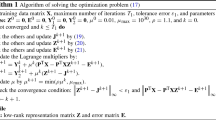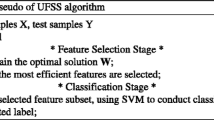Abstract
Discriminant subspace learning is a widely used feature extraction technique for image recognition, since it can extract effective discriminant features by employing the class information and Fisher criterion. A crucial research topic on this technique is how to rapidly extract sufficient and effective features. Recently, recursive discriminant subspace learning technique has attracted lots of research interest because it can acquire sufficient discriminant features. Generally, it recursively decomposes image samples and extracts features from a number of decomposed sample sets. The major drawback of most recursive discriminant subspace learning methods is that they calculate the projective vectors one by one, such that they suffer from big computational costs. The recursive modified linear discriminant method and the incremental recursive Fisher linear discriminant method employ a simple solution for this problem, which calculates the class number minus one projective vectors in each recursion. However, this solution produces the unfavorable projective vectors with poor discriminant capabilities, and it cannot provide the terminating criterion for recursive computation and make the projective vectors orthogonal. In this paper, we propose a novel recursive learning approach that is group recursive discriminant subspace learning, which can rapidly learn multiple orthogonal subspaces with each spanned by a group of projective vectors. And we present a rule to select favorable projective vectors per recursion and provide a matrix-form-based terminating criterion to determine the number of recursions. Experiments on three widely used databases demonstrate the effectiveness and efficiency of the proposed approach.







Similar content being viewed by others
Explore related subjects
Discover the latest articles, news and stories from top researchers in related subjects.References
Chen Y, Zheng WS, Xu XH, Lai JH (2013) Discriminant subspace learning constrained by locally statistical uncorrelation for face recognition. Neural Netw 42:28–43
Abiantun R, Prabhu U, Savvides M (2014) Sparse feature extraction for pose-tolerant face recognition. IEEE Trans Pattern Anal Mach Int 36(10):2061–2073
Kong A, Zhang D, Kamel M (2009) A survey of palmprint recognition. Pattern Recognit 42(7):1408–1418
Wu X, Zhao Q, Bu W (2014) A SIFT-based contactless palmprint verification approach using iterative RANSAC and local palmprint descriptors. Pattern Recognit 47(10):3314–3326
Belhumeur PN, Hespanha JP, Kriegman D (1997) Eigenfaces vs. fisherfaces: recognition using class specific linear projection. IEEE Trans Pattern Anal Mach Int 19(7):711–720
Turk M, Pentland A (1991) Eigenfaces for recognition. J Cogn Neurosci 3(1):71–86
Yan S, Xu D, Yang Q, Zhang L, Tang X, Zhang HJ (2007) Multilinear discriminant analysis for face recognition. IEEE Trans Image Process 16(1):212–220
Hamsici OC, Martinez AM (2008) Bayes optimality in linear discriminant analysis. IEEE Trans Pattern Anal Mach Int 30(4):647–657
Yang S, Lin M, Hou C, Zhang C, Wu Y (2012) A general framework for transfer sparse subspace learning. Neural Comput Appl 21(7):1801–1817
Zhao C, Lai Z, Miao D, Wei Z, Liu C (2014) Graph embedding discriminant analysis for face recognition. Neural Comput Appl 24(7–8):1697–1706
Cevikalp H, Neamtu M, Wilkes M, Barkana A (2005) Discriminative common vectors for face recognition. IEEE Trans Pattern Anal Mach Int 27(1):4–13
Yang J, Yang J (2002) Generalized K–L transform based combined feature extraction. Pattern Recognit 35(1):295–297
Wang X, Tang X (2004) Dual-space linear discriminant analysis for face recognition. In: IEEE conference on computer vision and pattern recognition, pp 564–569
Tao D, Li X, Wu X, Maybank SJ (2007) General tensor discriminant analysis and gabor features for gait recognition. IEEE Trans Pattern Anal Mach Int 29(10):1700–1715
Su Y, Shan S, Chen X, Gao W (2008) Classifiability-based optimal discriminatory projection pursuit. In: IEEE conference on computer vision and pattern recognition, pp 1–7
Wang R, Chen X (2009) Manifold discriminant analysis. In: IEEE conference on computer vision and pattern recognition, pp 429–436
Guan N, Tao D, Luo Z, Yuan B (2011) Manifold regularized discriminative non-negative matrix factorization with fast gradient descent. IEEE Trans Image Process 20(7):2030–2048
Luo D, Ding CH, Huang H (2011) Linear discriminant analysis: new formulations and overfit analysis. In: AAAI conference on artificial intelligence, pp 417–422
Zhong F, Zhang J (2013) Linear discriminant analysis based on L1-norm maximization. IEEE Trans Image Process 22(8):3018–3027
Chen S, Liu C (2014) Clustering-based discriminant analysis for eye detection. IEEE Trans Image Process 23(4):1629–1638
Kong D, Ding C (2014) Pairwise-covariance linear discriminant analysis. In: AAAI conference on artificial intelligence, pp 1925–1931
Iwata S, Nakatsukasa Y, Takeda A (2014) Global optimization methods for extended Fisher discriminant analysis. In: International conference on artificial intelligence and statistics, pp 411–419
Yang M, Sun S (2014) Multi-view uncorrelated linear discriminant analysis with applications to handwritten digit recognition. In: International joint conference on neural networks, pp 4175–4181
Li S, Fu Y (2014) Robust subspace discovery through supervised low-rank constraints. In: SIAM international conference on data mining, pp 163–171
Xiang C, Fan XA, Lee TH (2006) Face recognition using recursive Fisher linear discriminant. IEEE Trans Image Process 15(8):2097–2105
Wang J, Xu Y, Zhang D, You J (2010) An efficient method for computing orthogonal discriminant vectors. Neurocomputing 73(10):2168–2176
Xiang C, Huang D (2006) Feature extraction using recursive cluster-based linear discriminant with application to face recognition. IEEE Trans Image Process 15(12):3824–3832
Ohta R, Ozawa S (2009) An incremental learning algorithm of recursive Fisher linear discriminant. In: International joint conference on neural networks, pp 2310–2315
Ohta R, Ozawa S (2013) An improvement of incremental recursive Fisher linear discriminant for online feature extraction. Electron Commun Jpn 96(4):29–40
Ye QL, Zhao CX, Zhang HF, Chen XB (2012) Recursive “concave–convex” Fisher linear discriminant with applications to face, handwritten digit and terrain recognition. Pattern Recognit 45(1):54–65
Phillips PJ, Flynn PJ, Scruggs T, Bowyer KW, Chang J, Hoffman K, Marques J, Min J, Worek W (2005) Overview of the face recognition grand challenge. In: IEEE conference on computer vision and pattern recognition, pp 947–954
Georghiades AS, Belhumeur PN, Kriegman D (2000) From few to many: generative models for recognition under variable pose and illumination. In: IEEE international conference on automatic face and gesture recognition, pp 277–284
Zhang D, Kong WK, You J, Wong M (2003) Online palmprint identification. IEEE Trans Pattern Anal Mach Int 25(9):1041–1150
Cai D, He X, Han J, Zhang HJ (2006) Orthogonal laplacianfaces for face recognition. IEEE Trans Image Process 15(11):3608–3614
Kokiopoulou E, Saad Y (2007) Orthogonal neighborhood preserving projections: a projection-based dimensionality reduction technique. IEEE Trans Pattern Anal Mach Int 29(12):2143–2156
Kim TK, Kittler J, Cipolla R (2010) On-line learning of mutually orthogonal subspaces for face recognition by image sets. IEEE Trans Image Process 19(4):1067–1074
Gao Q, Ma J, Zhang H, Gao X, Liu Y (2013) Stable orthogonal local discriminant embedding for linear dimensionality reduction. IEEE Trans Image Process 22(7):2521–2531
Chen Y, Xu XH (2014) Supervised orthogonal discriminant subspace projects learning for face recognition. Neural Netw 50:33–46
Ye QL, Ye N, Zhang HF, Zhao CX (2014) Fast orthogonal linear discriminant analysis with applications to image classification. In: International joint conference on neural networks, pp 299–306
Jing XY, Zhang D (2004) A face and palmprint recognition approach based on discriminant DCT feature extraction. IEEE Trans Syst Man Cybern B 34(6):2405–2415
Jing XY, Wong HS, Zhang D (2006) Face recognition based on 2D Fisherface approach. Pattern Recognit 39(4):707–710
Draper BA, Yambor WS, Beveridge JR (2002) Analyzing PCA-based face recognition algorithms: eigenvector selection and distance measures. In: Empirical evaluation methods in computer vision, pp 1–15
Acknowledgments
The work described in this paper was fully supported by the National Natural Science Foundation of China under Project Nos. 61272273 and 61233011, the Major Science and Technology Innovation Plan of Hubei Province under Project No. 2013AAA020, the Research Project of Nanjing University of Posts and Telecommunications under Project No. XJKY14016, and the Postgraduate Scientific Research and Innovation Plan of Jiangsu Province Universities under Project No. CXLX13_465.
Author information
Authors and Affiliations
Corresponding author
Rights and permissions
About this article
Cite this article
Wu, F., Jing, XY., Yao, YF. et al. Group recursive discriminant subspace learning with image set decomposition. Neural Comput & Applic 27, 1693–1706 (2016). https://doi.org/10.1007/s00521-015-1966-0
Received:
Accepted:
Published:
Issue Date:
DOI: https://doi.org/10.1007/s00521-015-1966-0






